DDPAI » Product Manuals » N1 Dual
DDPAI N1 Dual
User Manual
Product Introduction
Appearance
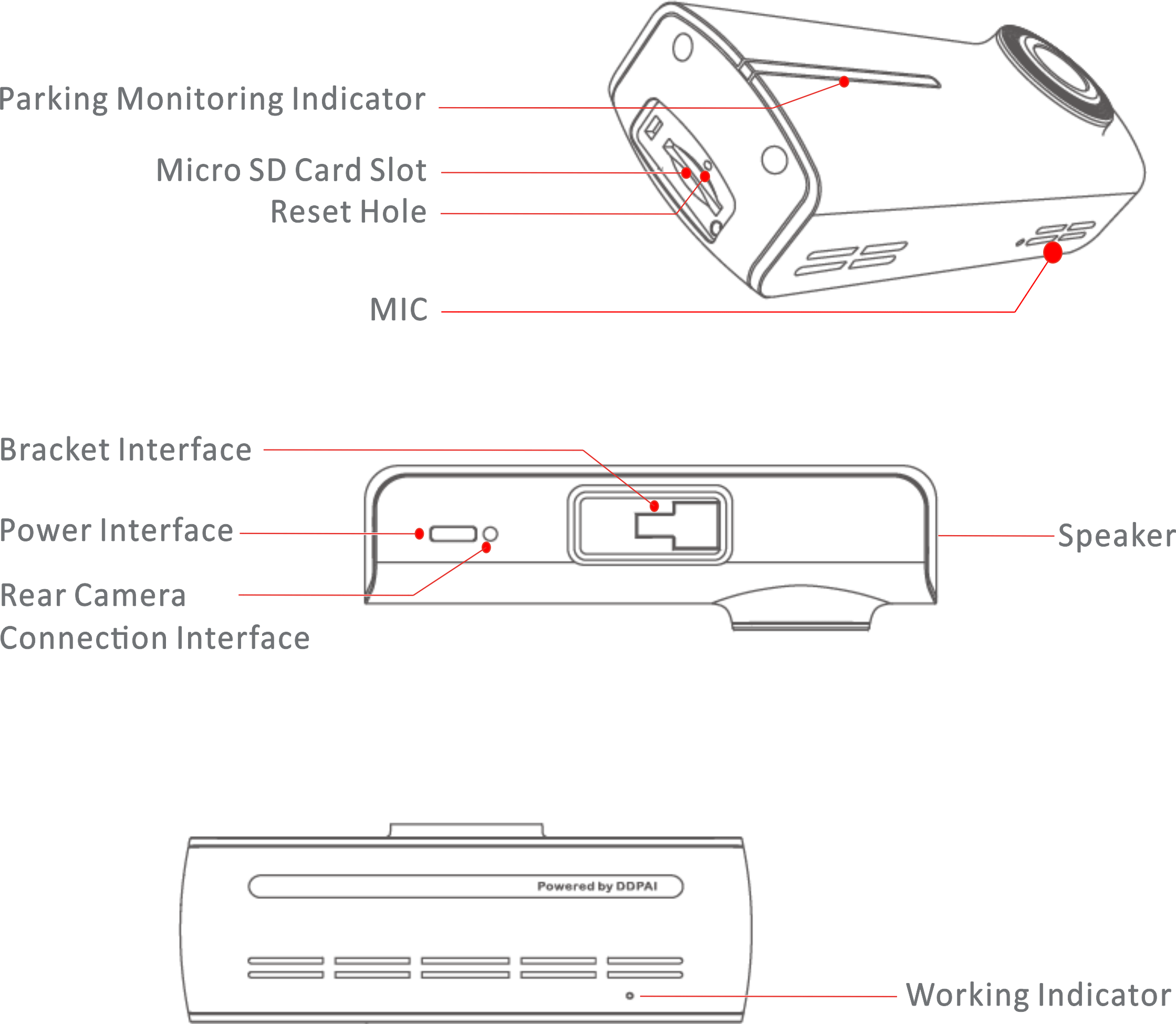
Indicator Guide
| Working Indicator | System Status |
| Breathing Blue | Recording |
| Flashes Blue | Storage Exception/Emergency Recording |
| Steady Blue | Power-on Moment |
| Steady Blue | Upgrading |
| Parking Monitoring Indicator | System Status |
| Breathing Red | Parking Monitoring |
| Flashes Red Quickly | Storage Exception/Emergency Recording |
| Steady Red | Upgrading |
Specifications
| Model | N1 Dual |
| Rated Input | 5V/1A |
| Storage Capacity | Support TF card (Max. 256GB) |
| G-Sensor | 3-axis G-sensor supports collision detection, triggers taking pictures in case of collision and rapid acceleration, and the sensitivity can be adjusted by the app |
| Resolution | Optional:
|
| Encoding Technology | Support Ai.265/H.264 encoding |
| Power Supply | 12V intelligent step-down line |
| Transmission | Type-C interface |
Installation Instructions
Dash Cam Installation
The wiring and power-taking installation method of the dash cam include the following two types:
● Cigarette Lighter Power Supply
Insert the car charger into the cigarette lighter, and connect the car charger and the dash cam through the power cord. Most of the power cord will be embedded in the plastic guard plate of the car, and a small part will be exposed in the car. This wiring method is simple and easy to operate.
Step 1: Wipe the front windshield
Wipe the front windshield with a clean soft cloth to ensure that the bracket can stick firmly.
Step 2: Install the dash cam on the bracket
Remove the dash cam and bracket from the package, and install the bracket on the dash cam.
Step 3: Power on the dash cam
After inserting the car charger into the cigarette lighter, connect the dash cam to the car charger using the specified Type-C power cord.
After the car starts, the dash cam will automatically start when it is powered on, and the start-up prompt tone “Hello, DDPAI” will be issued, and the dash cam will start recording at this time.
Step 4: Determine the installation position of the dash cam and adjust the lens angle
① After connecting the DDPAI App to the dash cam, enter the app, select “Device” > “Connect to Camera”, and enter the “Now&back” interface, where the horizontal center line and vertical center line are displayed.
② Place the dash cam in the middle of the front windshield, so that the bottom of the bracket is attached to the front windshield, and the lens faces outward. According to the horizontal and vertical center lines in the picture, move the dash cam left and right to ensure that the center line of the front of the car is at the vertical center line, and then rotate the device to ensure that the disappearing line of the ground plane is at the center line of the picture.
Note: Please refer to the horizon line and vertical center line to determine the position of the dash cam, otherwise it will affect the use of some functions of the dash cam.
Step 5: Stabilize the dash cam
① After determining the installation position of the dash cam, attach the electrostatic sticker to the installation position.
② Peel off the film of the 3M sticker on the bracket, and stick the bracket to the center of the electrostatic sticker.
Note: Please pay attention to the direction and position when attaching the 3M sticker which is a disposable item. Please confirm that the recording angle of the dash cam is correct before attaching.
Step 6: Wiring
As shown in the following figure, please place the power cord from the cigarette lighter receptacle to the fixed position of the dash cam, and hide the power cord in the plastic guard plate of the car by using the included crowbar.
Note: The cigarette lighter receptacle might be positioned differently in your car. The picture is provided for reference only.
● Connect the fuse box (step-down line is required)
This wiring method ensures neatness and beauty in the car and realizes the parking monitoring function at the same time. But the wiring operation is complicated. To avoid vehicle damage caused by misoperation, please complete the installation at a professional automobile service shop.
Note: The step-down line needs to be purchased separately or by purchasing a package including the step-down line.
SD Card Installation
Please make sure the lens of the dash cam is facing up, and the chip of the SD card is facing up, then insert the SD card into the slot. Please refer to the silkscreen printed pattern beside the SD card slot to install the SD card.
Note: SD card hot plug is not supported, you can restart after hot plug is abnormal to return to normal.
APP Connection
Connecting N1 Dual with Smart Phone
Note: As the APP is constantly upgraded, the actual operation may be slightly different from the following description. Please connect your device to a phone according to the prompts in the DDPAI App.
Step 1: Downloading the DDPAI App
Please scan the QR code below or search for“DDPAI” in the Google Play Store (Android) or App Store (iOS) to download the DDPAI App.
Step 2: Connecting N1 Dual with Smart Phone
The dashcam has built-in wireless Wi-Fi module, and the mobile phone can be directly connected with it to form a wireless local area network. Through the wireless data transmission function, you can preview, playback, download and share driving videos and photos in real-time in the app.
Note: The above operation does not consume mobile phone traffic. The built-in Wi-Fi of the dashcam cannot be used as a mobile phone data network or as a hot spot. After scanning the QR code and downloading the app, you can operate and set up the dash cam on your phone.
① Open the DDPAI App, enter the “Device” page, tap “+ Connect New Device“, enter the “Choose your device” interface, and then tap “Screen-less Dash Cam“.
② Tap “Next” > “Connect to Wi-Fi” in turn, and the detected Wi-Fi of the dash cam (such as DDPAI_N1 Dual_XXXX) will be displayed. Tap Connect.
③ Connect your phone to the built-in Wi-Fi “DDPAI_N1 Dual_XXXX” of the dash cam, and the default password is 1234567890.
▶ For iPhone: When you enter the“Settings”interface, select “WLAN” > “DDPAI_N1 Dual_XXXX“, enter the initial password (1234567890), and tap Join.
▶ For Android phones: In the Wi-Fi list, select “DDPAI_N1Dual_XXXX”, enter the initial password(1234567890), and tap Connection.
④ After successful connection, you can directly enter the “Now&back” interface of DDPAI App.
Note:
When you connect the dash cam for the first time, you will be prompted:
● To modify the Wi-Fi password: Please modify it according to your needs, and save the password properly after modification (if you forget the password, please hold the reset button on the dash cam with a pin for 6 to 8 seconds to restore the factory settings, and then reconnect the dash cam with the initial password).
● Whether to enable high-compression video encoding: It is recommended to enable. After enabling, the recorded video quality will be improved, which is clearer than the default configuration.
Interface Introduction
Now&back
After the app is successfully connected, the “Now&back” interface will be displayed. In this interface, you can preview live video, playback video, take pictures, download video files or set up the device.
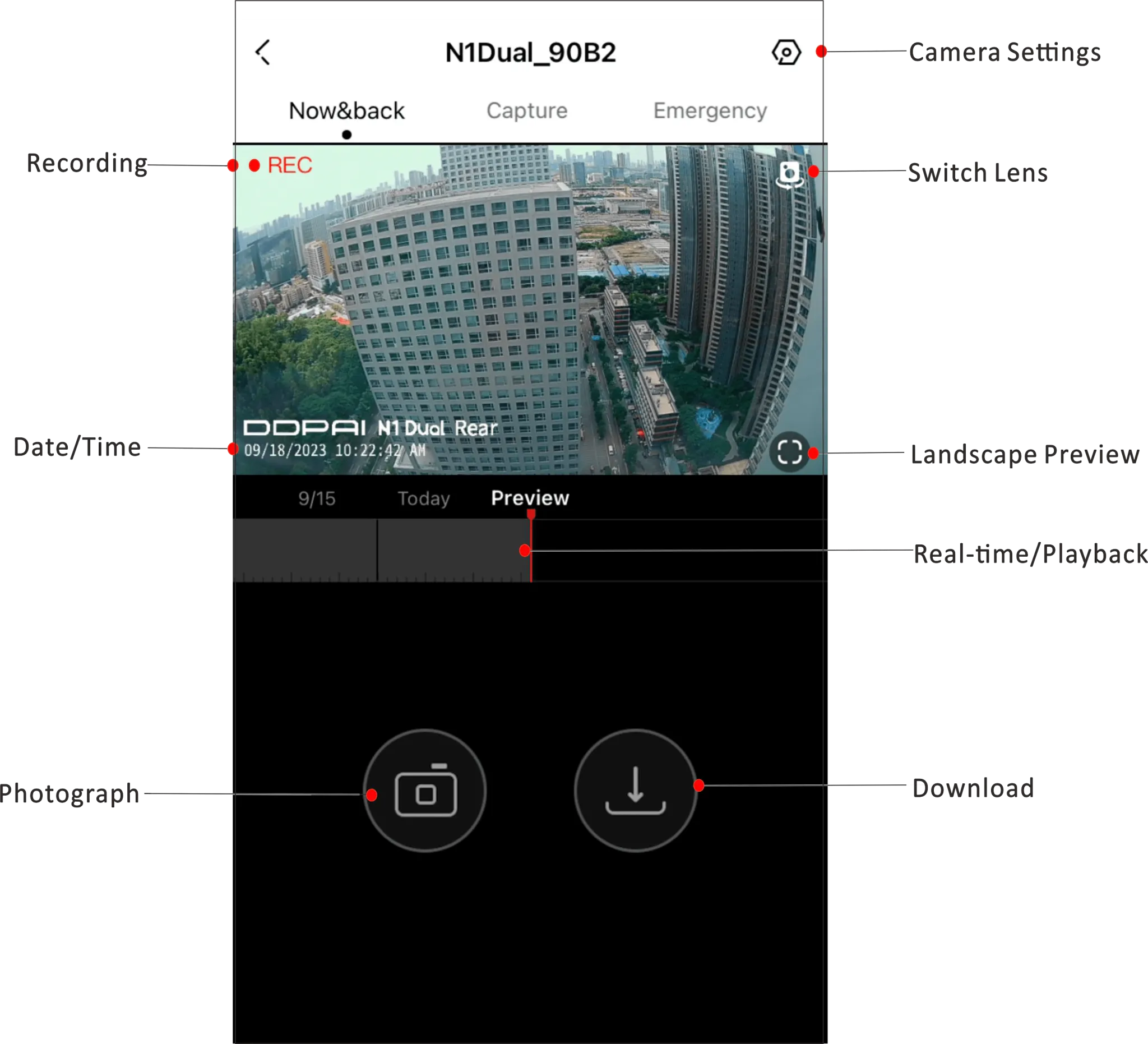
Capture
When you tap on the Now&back interface, you can view the snapshot photo on this interface.

Emergency
When the device is in operation, a detected collision (emergency situations such as vehicle emergency braking or collision) will trigger taking a photo and an emergency related video, which can be viewed in the “Emergency” interface. See Chapter 5 “Collision Detection & Locked Videos” for details.
System Settings
In the “Now&back” interface, click to enter the Settings page, where you can check the various parameters of the dash cam.
● Voice Control
You can set the speaker volume and start-up tone.
| Settings | Details |
| Speaker volume | Adjust the speaker volume |
| Start-up sound | You can select to enable/disable the start-up sound (default: enable) |
● Preview Display
You can enable the installation guide or flip the image of the rear camera vertically or horizontally.
| Settings | Details |
| Recorder installation guide | You can choose to enable/disable the function (default: disable). After the function is enabled, the real-time preview interface displays the installation guide line. |
| Flip the image of the rear camera vertically | You can select to enable/disable the function (default: off) |
| Flip the image of the rear camera horizontally | You can select to enable/disable the function (default: off) |
● Recorder Recording
You can set video encoding, recording resolution, video duration associated with photographing, photographing sensitivity, etc.
| Settings | Details |
| H.264/Ai.265 video encoding | The video is recorded with H.264 encoding by default. You can set Ai.265 encoding through the app, which will improve the picture quality by 50% and requires higher mobile phone performance. If the video freezes during playback, you can turn off this option or preview the video on the computer. |
| Recording resolution | You can select 1296P/(full HD) 1080P, and the default setting is 1296P |
| Microphone recording | YYou can select to enable/disable the function (default: enable) |
| Date and time display | You can select to enable/disable the function (default: enable) |
| Create related video clip when taking a photo | When the device is in working condition, an emergency photo and an emergency related video will be automatically generated when a collision is detected. You can set the duration of the emergency related video. For details, see Chapter 5 “Collision Detection & Locked Videos” > “Set the duration of emergency related video |
| Camera sensitivity | When the device is in working state, it will automatically take pictures when it detects collision. You can set the sensitivity of taking pictures. The higher the sensitivity is set, the easier it is to trigger taking pictures. If this function is turned off, the collision detection & locked video function will not be available. For details, see Chapter 5 “Collision Detection & Locked Videos” > “Setting Camera Sensitivity” |
● Shutdown Settings
For vehicles where the cigarette lighter is not powered off after the car is shut down and locked, the dash cam will shut down after 15 mins of parking.
| Settings | Details |
| Automatically shutdown after 15 mins of parking | You can select to turn on/off this function (default: off). If this function is turned on, the dash cam will automatically shut down after 15 mins of parking. |
● Parking Monitoring
When you select the intelligent step-down line, you can set the parking mode, parking monitoring duration and vehicle battery protection voltage. See Chapter 5 “Parking Monitoring” for details.
| Settings | Details |
| Parking mode | After the vehicle is turned off, you can choose to enter time-lapse video recording/normal video recording/sleep |
| Video duration selection | Set the duration: 12 hours, 24 hours (default), 48 hours |
| Vehicle battery protection | Set the battery protection voltage: High (12.4 V), middle (12V)(default), low (11.8 V). When the charge of the vehicle battery is lower than the selected voltage, the dash cam will be turned off automatically to prevent the battery from losing power. |
Note: This function needs to be realized by optional step-down line.
Management
You can set the Wi-Fi password or name, format your TF card, or view information such as device model No., firmware version, etc.
| Settings | Details |
| Dash Cam Wi-Fi Name | You can set the Wi-Fi name |
| Dash Cam Wi-Fi Password | You can set Wi-Fi password |
| Storage management | You can check the storage capacity, and choose to format the TF card (note: formatting will cause the device data to be cleared, please operate with caution) |
Function Introduction
Video Function
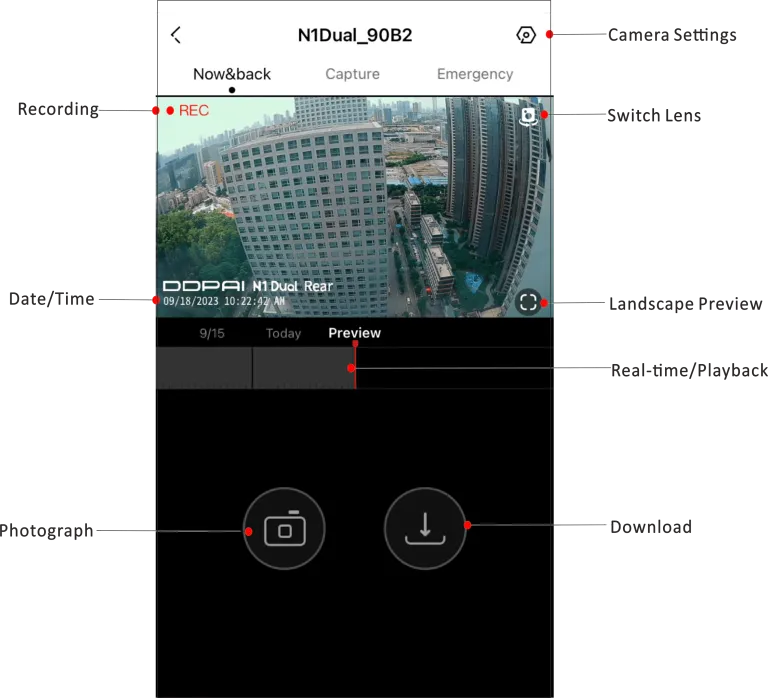
● Preview video
After the App is successfully connected to the dash cam, enter the real-time preview interface, click the horizontal screen button, and the real-time picture will automatically switch to the full-screen preview mode.
● Playback video
1. Enter the preview interface, and tap on the screen will display the progress bar;
2. Drag the progress bar to select the time starting point to view;
3. Click on the thumbnail or wait for 5 seconds to start playing the previously recorded video.
● Download video
1. Enter the preview interface, and tap on the screen will display the progress bar;
2. Drag the progress bar to select the time starting point to download;
3. Tap Download to start downloading, and tap Complete to finish downloading. After downloading, the file is saved to the local photo album, which can be shared and deleted.
Photographing Function
This dash cam supports the following two photographing modes:
▶ Collision sensing photography: The dash cam will automatically take pictures when it senses the collision or emergency braking of the vehicle.
▶ Manual photographing: Enter the “Now&back” interface, Tap to take a photo.
● View photos or videos on the device
After connecting the dash cam to the mobile phone, open the DDPAI App. In the “Capture” interface, you can view the captured photos and videos on the dash cam.
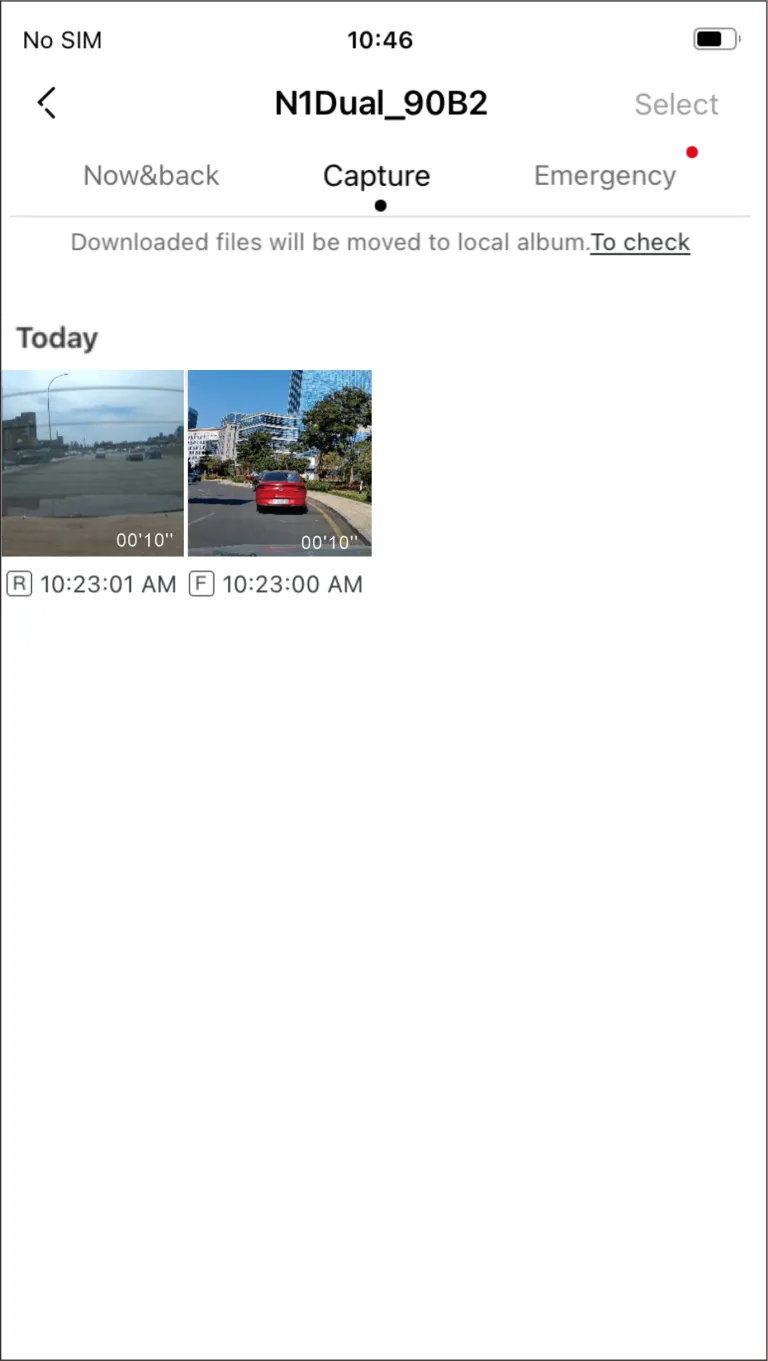
● View photos or videos on your phone
When the captured photos/videos on the device are downloaded to the local album of your phone, they will be moved to the mobile phone for storage, and can be viewed without connecting the mobile phone to the dash cam. Open the App and enter “Me” interface > tap “Local Album” to enter the local album interface, and you can view photos or videos downloaded to your phone.

Automatically download event photos/videos:
You can choose to automatically download event photos/videos to the local album after connecting the device. Open the app, enter “Me” interface> tap “APP Settings”, enable “Automatically download event image” / “Automatically download event video” function.
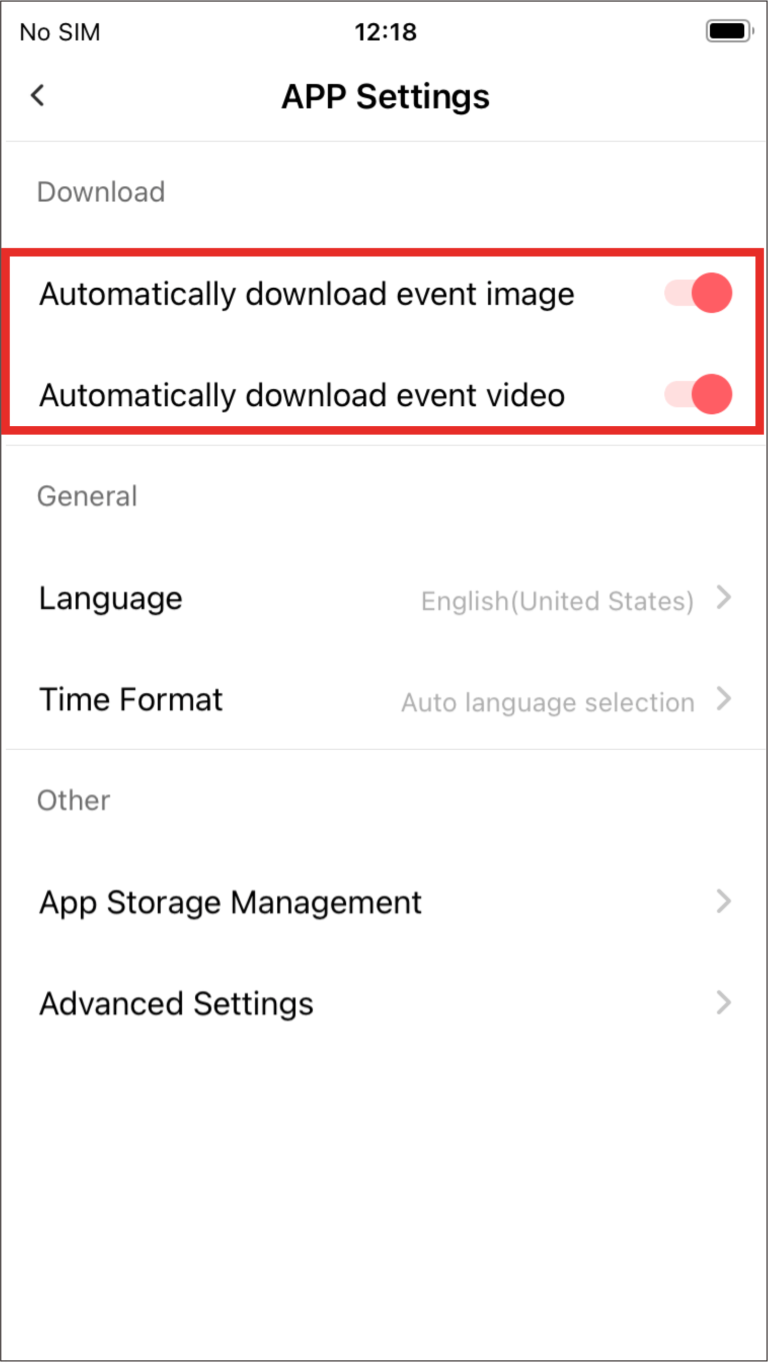
● Share/delete photos or videos
After entering the “Local Album” interface, tap Select to delete videos, pictures, and emergency files downloaded to your phone or share them to social media accounts.
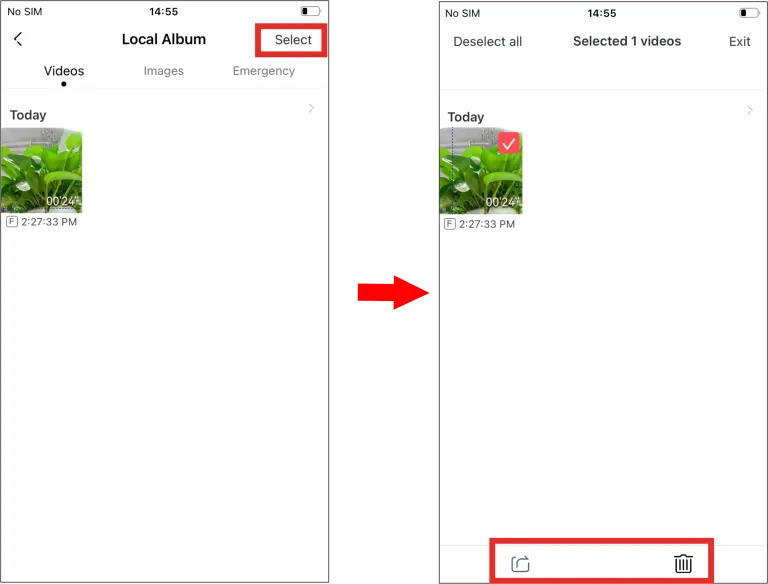
Parking Monitoring
When you select the step-down line to take power, the parking monitoring function can be realized. After the vehicle is turned off, the dash cam will automatically enter the parking monitoring mode, and will automatically record if there is an abnormal collision. You can set the parking mode, parking monitoring time and vehicle battery protection voltage value.
① After the mobile phone is connected to the dash cam, open the app, enter the “Device” interface, tap “Enter the device”, and you will enter the “Now&back” interface;

② Tap (Camera Settings) on the upper right corner of the interface and enter “Camera Settings” interface > “Parking mode” / “Parking Monitoring Duration” / “Vehicle Battery Protection”.
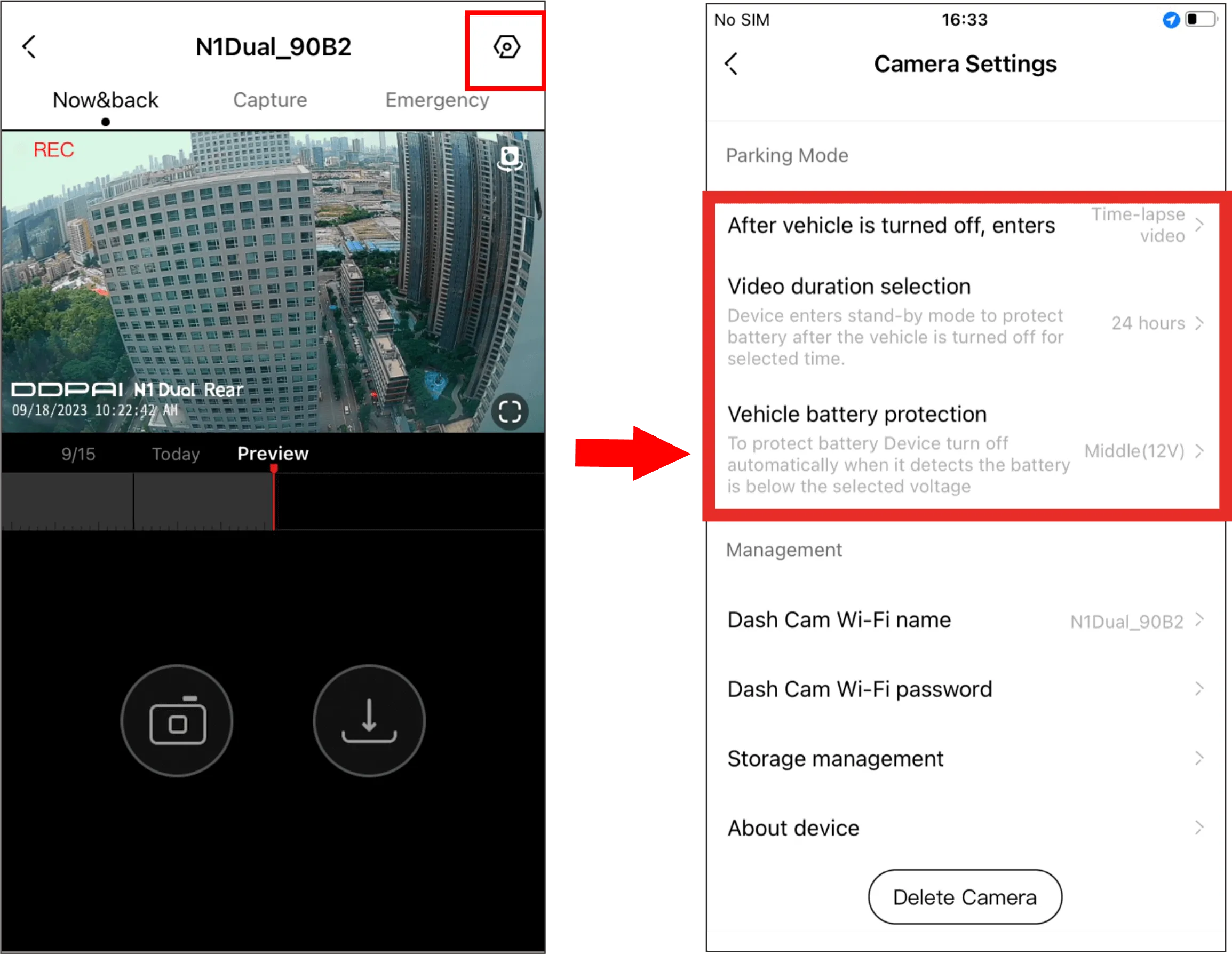
| Settings | Details |
| Parking mode | After the vehicle is turned off, you can choose to enter time-lapse video recording/normal video recording/sleep |
| Video duration selection | Set the duration: 12 hours, 24 hours (default), 48 hours |
| Vehicle battery protection | Set the battery protection voltage: High (12.4 V), middle (12V) (default), low (11.8 V). When the charge of the vehicle battery is lower than the selected voltage, the dash cam will be turned off automatically to prevent the battery from losing power. |
Parking Mode: Time-lapse video recording
After the car is turned off, it will enter time-lapse recording. It will shut down after reaching the set time or detecting low voltage. After shutting down, it can only be awakened by the ignition.
Parking Mode: Normal video recording
Normal recording will be maintained after the car is turned off. It will shut down after reaching the set time or detecting low voltage. After shutting down, it can only be woken up by the ignition.
Parking Mode: Sleep
After the car is turned off, it enters the sleep mode. After a collision, it will wake up and work for 2 minutes. It will delay taking the photo for 5 seconds and generate a 10-second video (photo file name starts with “G” and ends with “L”). In addition, it will remind you the collision event when waking up next time.
Collision Detection & Locked Videos
When the dash cam is in working mode, when a collision is detected (such as a sudden braking or collision of a vehicle), it will generate an emergency photo and an emergency-related video, and store them separately. These files will not get deleted by loop cycle function.
● Setting Camera Sensitivity
The higher the sensitivity of the dash cam, the easier it is to trigger photographing; The lower the sensitivity of the dash cam, the less likely it is to trigger photographing.
The default collision sensitivity of the dash cam is “Medium”, and it supports the selection of collision sensitivity in seven levels: “High”, “Medium-high”, “Medium”, “Medium-low”, “Low”, “Off” and “Custom”.
Select the appropriate collision sensor sensitivity. In emergencies such as vehicle collision or sudden braking, the dash cam will be triggered to take pictures and generate an emergency photo and video. If you select “Off”, in emergency situations such as vehicle collision or sudden braking, there will be no photos and videos. You can switch the collision sensing sensitivity of the dash cam through the following steps.
① After the mobile phone is connected to the dash cam, open the app, enter the “Device” interface, tap “Enter the device”, and you will enter the “Now&back” interface;

② Tap (Camera Settings) on the upper right corner of the interface to enter the “Camera Settings” interface > “Camera sensitivity ” > “Driving” / “Parking”, set the appropriate sensitivity.
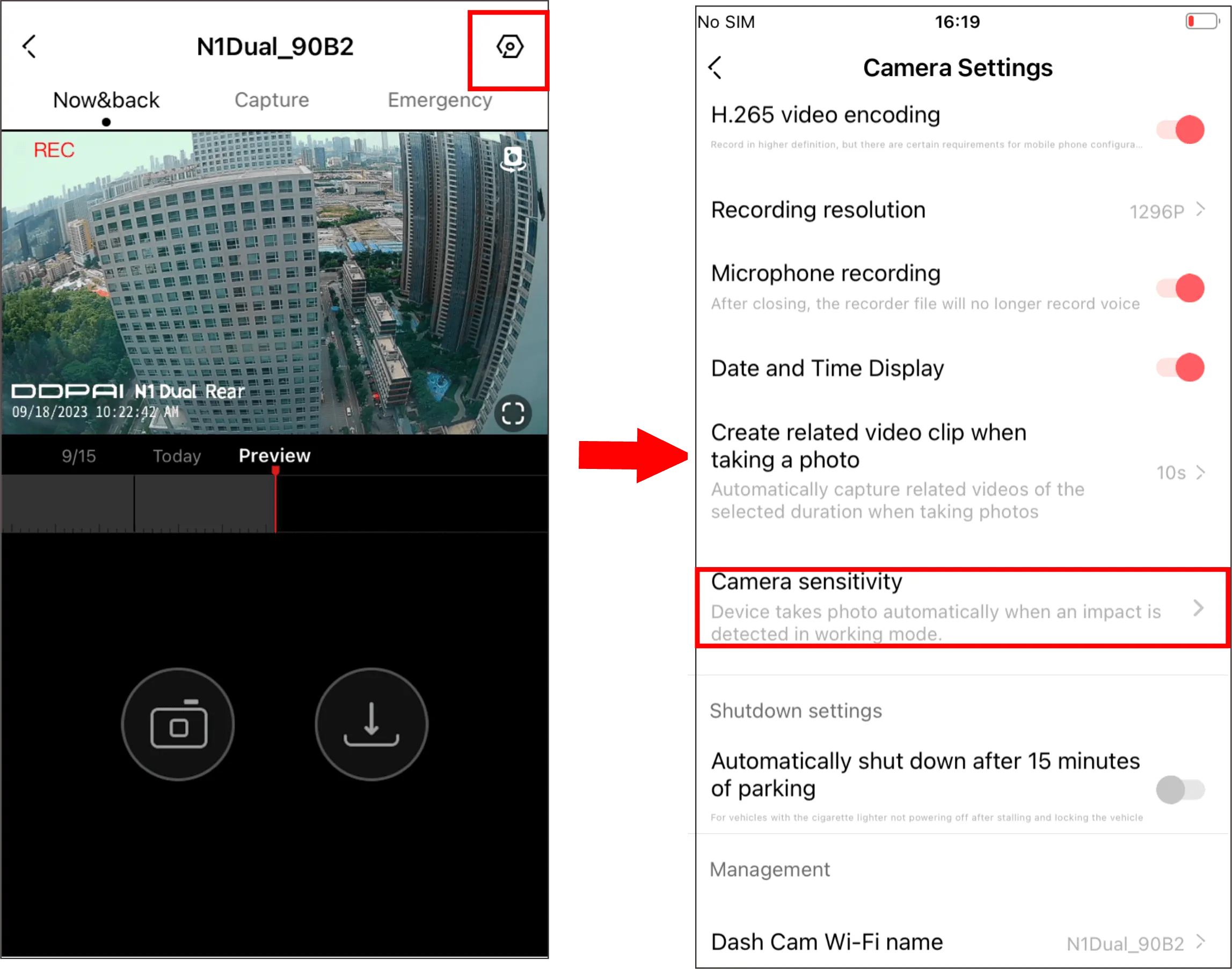

| Settings | Definition |
| High | A very slight collision will trigger the photo taking, and it is very likely to be triggered when the road conditions are bumpy |
| Medium-high | A slight collision will trigger taking pictures, and it may also be triggered when passing a speed bump |
| Medium | A normal collision will trigger photo taking, and it may also be triggered when passing through the speed bump at high speed |
| Medium-low | A strong collision will trigger photo taking |
| Low | Photography will only be triggered under strong impact |
| Shut down | This function will not be available after it is turned off |
| Customize | Set according to individual needs |
● Set the duration of emergency related video
The default emergency related video duration of the dash cam is “10s” and supports three emergency related video duration options: “10s”, “20s” and “30s”. You can set the duration of the emergency related video by following these steps.
① After the mobile phone is connected to the dash cam, open the app, enter the “Device” interface, tap “Enter the device”, and you will enter the “Now&back” interface;

② Tap (Camera Settings) in the upper right corner of the interface to enter the “Camera Settings” page, and tap “Create related video clip when taking a photo” to set the photo-related video duration.
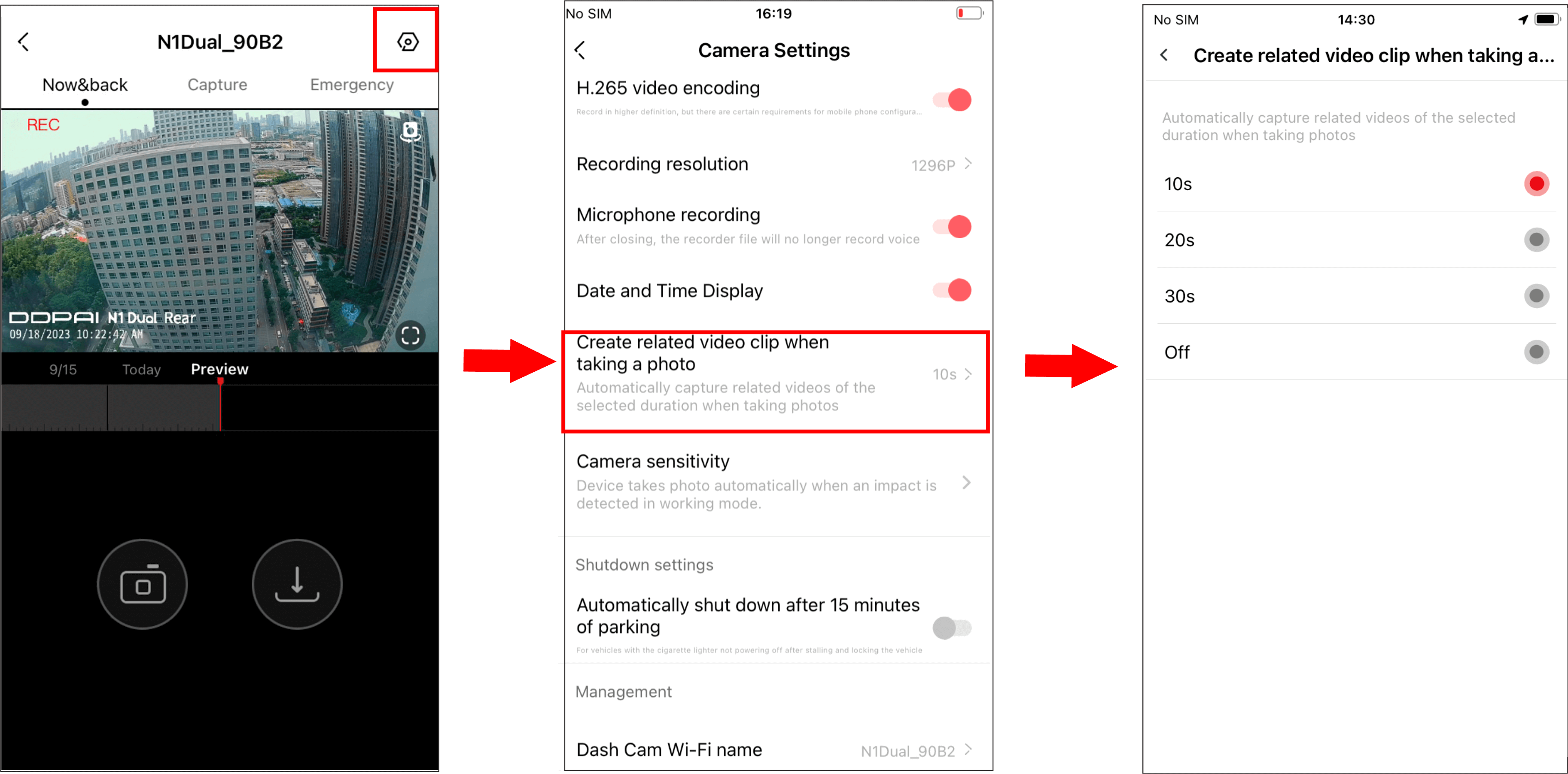
| Settings | Definition |
| 10s | After the dash cam detects a collision, it will generate an emergency related video of 5 seconds before and after the shooting time. |
| 20s | After the dash cam detects a collision, it will generate an emergency related video of 10 seconds before and after the shooting time. |
| 30s | After the dash cam detects a collision, it will generate an emergency related video of 15 seconds before and after the shooting time. |
| Off | After the dash cam detects a collision, it will generate an emergency related video of 5 seconds before and after the shooting time. |
Data Transmission
Gently remove the TF card from the card slot of the dash cam, insert it into the card reader, then plug it in the computer, open the DCIM folder, and browse or edit the photos or video files saved in the dash cam.
● 200 video: This folder contains normal recorded videos and time-lapse recorded videos in parking monitoring mode. The folder name of normal recorded video begins with numbers, and time-lapse recorded video begins with “S”; Ai.265 encoded recorded video ends with “H”.
● 201 photo: This folder contains photos generated by collision sensors. Normal photographs begin with “N”; Collision-sensing pictures begin with “G”.
● 202 thumb: This folder contains thumbnails.
● 203 gps: This folder is used to store G-sensor data.
Maintenance
Firmware Upgrade
Open the DDPAI App, connect the dash cam Wi-Fi, and tap “Me”>”About DDPAI”>”Detect New Version” and the app will automatically detect whether the App version and the firmware version are the latest versions. If there is a new version of the firmware of App or device, upgrade the version according to the operation displayed on the screen.
Safety Precautions
Before using this product, please read all precautions and operating instructions to ensure correct and safe use.
1. Please do not debug the N1 Dual dash cam or watch the video on your mobile phone while driving, and pay attention to driving safety.
2. Please do not install the N1 Dual dash cam in a location that may block the driving view.
3. Make sure to use the power cord included in the product package. Other power cords may cause fire or short circuit and electric shock due to defective products.
4. Make sure to use Class 10 high-speed card (Max. 256GB). When using the device, please do not insert or remove the TF card. Please format it through the App before use, otherwise it will not be recognized. It is recommended to format the dash cam regularly through the app to ensure better maintenance of this product.
5. Please do not open the dash cam shell or repair it yourself. If this product fails, please call the official customer service for relevant consultation.
6. The dash cam is not only suitable for vehicles, but can also be used in other places and can be powered by an adapter.
7. If a power adapter is used for power supply, an adapter that meets standard requirements should be purchased for use.
8. The pictures in this operating guide are for reference only, please refer to the actual product.
FAQ
FAQ
How do I format a memory card?
After the mobile phone successfully connects to the device, enter the “Camera Settings” interface, tap Management and select Format to format the card.
How to export the driving video in the memory card?
Use the card reader to connect the TF card with the computer, and you can export the driving video.
What do folders in a TF memory card stand for?
There are four folders under DCIM folder in TF memory card. See the following table for details of each folder.
| Folder Name | Details |
| 200 video | There are two status files in this folder: Normal video files, such as 20190719161640_0060.mp4, “60” indicates the duration of the video in seconds. Time-lapse video files start with “S”, such as S_20190719154514_0364_0030.MP4, “30” indicates the frame rate, that is, 30 frames per second, and “364” indicates the length of the video in seconds. |
| 201 photo | The photo triggered by the collision begins with “G”, for example, G_20190524113544_035_0005_L.jpg, and “L” indicates that there is associated video, which will not be covered by loop. |
| 202 thumb | Used to store thumbnails |
| 203 gps | Used to store G-sensor data |










